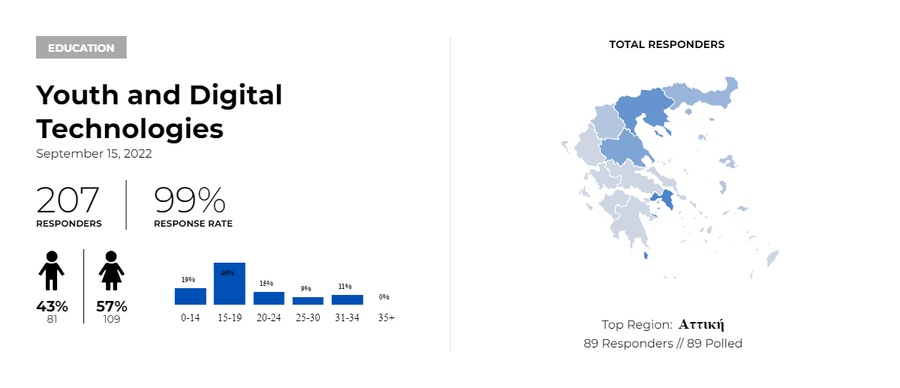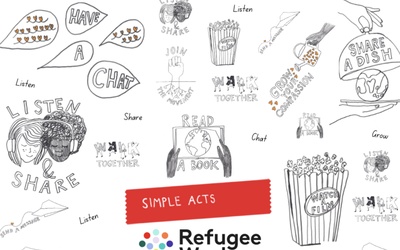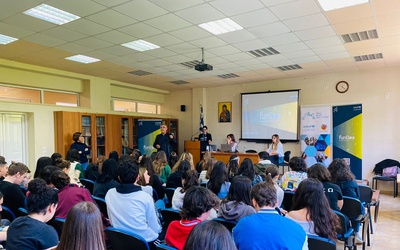The goal of this poll was to explore the frequency and the way digital technology and digital tools are used by young people and adolescents; if they benefit from using the internet in their education and in general in their daily activities, and if “digital skills” could be considered as a domain of learning and socializing. It also aimed to explore their knowledge of online protection issues and investigate further what changes must be made to address digital inclusion or the digital divide.
207 U-Reporters participated in the poll, corresponding to a 99% response rate. Most of the respondents (57%) were between the ages of 15-19, while 19% were below 15 years old. Girls were more active than boys, representing more than half (57%) of the respondents. The top region the participants came from was Attica, followed by Central Macedonia and Thessaly.
According to the results, most of the U-Reporters (60%) that participated in the poll use their smartphones in their everyday life, followed by laptops (22%), tablets (10%), and desktops (8%). Also, more than half of U-Reporters (57%) use their digital devices between 2-6 hours, while 24% make use of them for over 6 hours daily.
Responding to the question regarding the three main uses of digital devices, the U-Reporters chose the following: 27% use digital devices to download videos and music, 20% to communicate with family and friends, and 14% to spend time on social media.
Furthermore, 65% of the respondents stressed that digital tools could facilitate the learning process of all children, while 20% stated their uncertainty on the matter, and 15% said that digital tools cannot facilitate their learning process. Responses indicating the latter included: ‘not all children have access to digital tools, and if they do, it may be limited. Children with learning disabilities may also find it difficult to adapt to the use of digital media for learning and teaching’, ‘digital devices distract young people’, and ‘students become passive objects and are forced into a sitting position with no movement’.
Most participants (90%) said that they have used a digital device to facilitate their learning and studying process and only 10% said they haven’t; specifically, 27% of the respondents that have used digital devices said that they use them to watch videos that help them understand better a science or a grammar phenomenon, while another 27% use digital tools to develop digital content (e.g. a PowerPoint presentation, a video, a slide show, etc.). 24% also prefer to use a digital device to enhance their knowledge in a foreign language (English, Greek, German etc.), and 22% to communicate and collaborate with their classmates in the preparation of a school project or assignment.
Regarding the challenges that young people face using digital technology, participants mentioned that ‘the information found on the internet is not always correct, leading the reader to wrong conclusions’, ‘my eyes get tired from the long hours on the internet’, ‘lots of commercials is a problem’. The difficulty in determining how useful the information is was stressed by 23%, followed by 18% who find the way the website is designed confusing and 17% who find it hard to decide the best keywords for online searching. Moreover, nearly 13% responded that sometimes they end up on websites without realizing how they got there, while 11% said they get tired when looking for information online, and 10% that sometimes they feel that their self-esteem decreases while navigating in digital environments, and 6% said that they don’t feel secure concerning their personal information they could share via social media.
More than half of them (57%) said that they are not aware of any cyberbullying incidents that happened within their social network, and 43% stated the opposite.
Asked whether they are aware of the reporting pathways in case of cyberbullying incidents, most of the participants (46%) said that they do know the formal report pathways (police, etc.), while 19% stated the opposite. 35% said they were aware and that they would report the incident to a trusted adult (teachers, parents, etc.).
Regarding the protection of their online data, 49% of U-Reporters said that they know what they should do to protect their data/privacy online, while nearly 50% said they were unsure or did not know what action they should take.
Finally, in responding to what sort of online personal security issues U-Reporters can deal with, 25% chose the deactivation function concerning their geographical position (e.g., Facebook, apps), 24% chose the function of changing the sharing settings of social media to see what others can see about them. The order of preference for the rest options was as follows: 24% responded they can post pictures/videos of other people online when having their permission, 17% use “report abuse” buttons on social media sites, and 15% realize that downloading music, movies or other material may be illegal.








